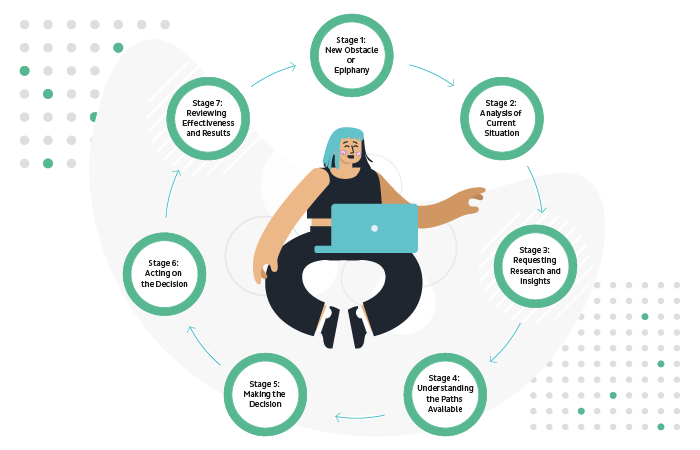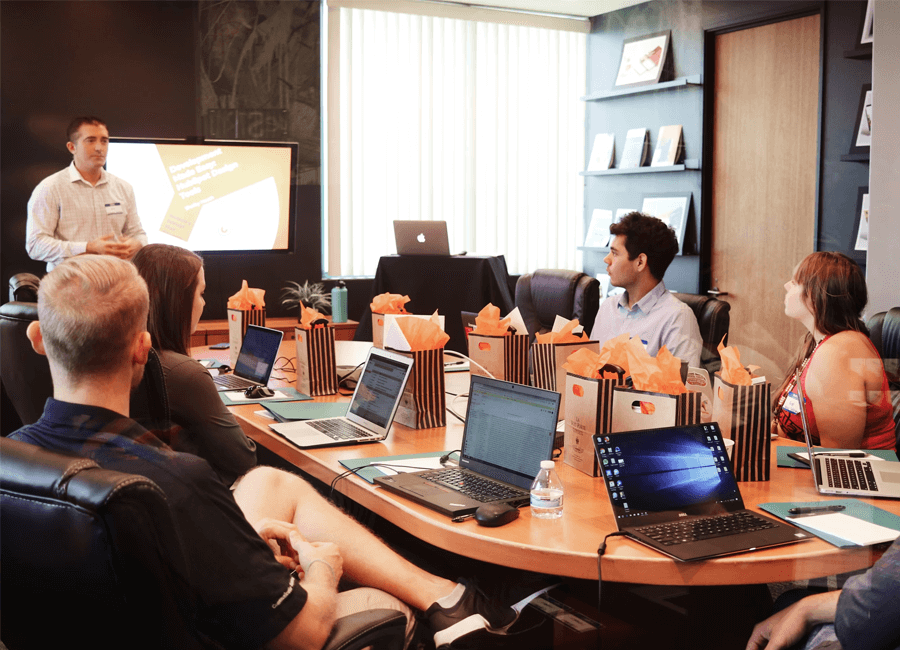Stakeholder decision-making is a subject filled with a lot of emotional charge on both sides – researchers want to help stakeholders make decisions with powerful insights, but sometimes can’t get them across just right to make stakeholders act on them enough because they don’t truly understand what goes into their decision-making process.
How do they decide which business problems are worth requesting research and insights to fix? How do we get them to decide to request more research to make more informed decisions? To truly understand how insight experts can influence stakeholder decisions with insights, we must first understand the lifecycle of the decision-making process.
| Tweet This | |
| Understanding the lifecycle of the stakeholder decision-making process can help insight experts insert insights into the right stage so that stakeholders pay attention. |

Stage 1: A New Obstacle or Epiphany is Identified
If this were a film, this would be called the inciting incident – a sudden situation or realisation that kickstarts the true plot within the story. In the case of stakeholders within a business, this first stage kickstarts their decision-making process.
The first stage of the decision-making lifecycle, is to understand that there’s a decision to be made. This typically comes when encountering an obstacle or challenge of some kind, or when stakeholders have an epiphany – this could be an idea for a great new strategy or a way to make a process more efficient – either way, this calls for a decision to be made to make sure that the right outcome is achieved.
Stage 2: Analysis of Current Situation and Alternative Paths
Once the decision-making process has been started, it’s time for stakeholders to assess their situation in stage two. If an obstacle has been encountered, then ensuring that the stakeholders involved understand the true extent of its damage is essential before they can fully tackle the problem at hand, and that in turn will help lead them to the potential paths they can take to resolve it.
If an epiphany is the inciting incident, then understanding the current business contexts it will influence in all its components will help stakeholders know exactly where their new potential strategy or idea fits in to make it better or eliminate any extraneous processes. If an idea is the cause of the decision, it’s also a good idea to take stock of any other team members/stakeholders who will be impacted with this new idea, and see if they have any useful input when turning this idea into reality.
Even if this is challenge-incited, this stage requires the stakeholders effected to ask others for help, information and assistance in making the best decision possible – which brings us to stage three: asking the insights team for research.
Stage 3: Requesting Research Assistance
Asking insight experts for help should be stage three, whether that’s for a brand-new research project or if they already have some insights on the matter from previous projects. Searching for insights to inform their decision is a crucial step in the process, and which path stakeholders take to obtain insights depends on two things: first, if they have access to a research team, whether in-house or through a research agency; and secondly, whether stakeholders have access to already-generated insights.
If stakeholders have an in-house team or resident insight expert then they should also have a dedicated place to store historical insights. This should increase the access to insights and speed up the decision-making process. In-house insight experts will also understand the relevant business contexts surrounding each decision and challenge; however, research agencies are able to take a step back and use the contexts provided by the stakeholders with their unique expertise to create the right research experience. Once the insights have been generated and communicated to stakeholders, it’s time to move onto stage four.
Stage 4: Analysing Alternative Paths with Insights
Now that stakeholders have the insights they need, whether they’re still relevant insights from a data warehouse or freshly generated by insight experts, stakeholders can now reanalyse the options available to them.
The insights generated from stage three are the key to making the right decision, if the insights are created from well-designed and executed research projects then stakeholders stand a better chance of making the most positive impact. If am obstacle or error has been identified in the customer or brand experience, then insights are able to point the way to the right fix.
If a new opportunity has come to light, then the insights generated can help stakeholders understand exactly how to implement it in order to enhance the brand or customer experience. This would work particularly for any new products or services, or even new business strategies to help the brand expand into different industries. However, there might be cases where the insights simply narrow down the choices involved, rather than eliminate options entirely, stakeholders will always have the final say.
Stage 5: Making the Decision
This is a simple stage, but perhaps the hardest if there are equally suitable options available to choose from. Making a decision is a stage all on it’s own, as stakeholders take stock of the last few paths laid out in front of them and finally choose the right one.
The timescales involved in the decision-making lifecycle entirely depend on the decision itself – is it important enough to take the time to choose? Is there a time limitation that requires a speedy result for maximum effectiveness? Will all of the options have the desired result or is there some discrepancy in the outcome depending on the decision? Whatever the situation, as soon as the decision is made it’s time to set the plan into motion in the next stage.
Stage 6: Set Plan into Motion
Once the decision is final, it’s time to move forward and act on it. Getting stakeholders to act on insights is one of the trickiest parts of an insight professional’s job, so there is a lot of literature out there on how to get stakeholders to listen to insights and use them within decision-making processes.
As soon as the decision is set, the relevant teams are notified and things start moving, stakeholders will start to see whether they made the right decision, whether the action plan is working as it should and either moving the business over the obstacle in it’s path or jet setting into future success on the back of the new opportunity. This stage lasts from the minute the plan is set in motion to the moment stakeholders don’t need to actively do anything to keep it going.
| Tweet This | |
| There are 7 stages to the Stakeholder Decision-Making Lifecycle - from the inciting incident to reviewing their success, there are many chances for insight experts to leave their mark. |
Stage 7: Review Outcomes and Learnings
This last stage allows stakeholders to take a step back and see exactly what it is they have done; once the results of their decision start to make themselves known, it’s time for stakeholders to review the success of their decision.
Sometimes this leads to tangible changes throughout the organisation, an uptick in new custom, or a surge in demand for a new product or service. But other times, the results come in intangible forms, where the results aren’t necessarily noticed through data, but they are felt across the organisation all the same.
Maybe stakeholders have implemented a new policy that helps their staff feel more valued, or they have gotten rid of superfluous processes to make the brand experience more efficient but still as impactful, these types of results might not make a huge difference in terms of quantitative outputs, but they all aid towards a better vibe or feeling about the brand and business.
Taking these results and understanding how they have been achieved is vital for future successful decision-making processes. In this stage, stakeholders can learn from their decisions, review the options that were available and see if any of them might have had the same or better impact, and then use that information to act accordingly in the future when a similar arises.


















